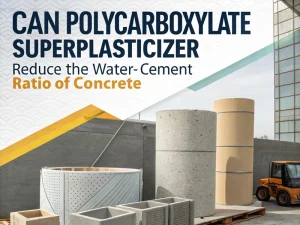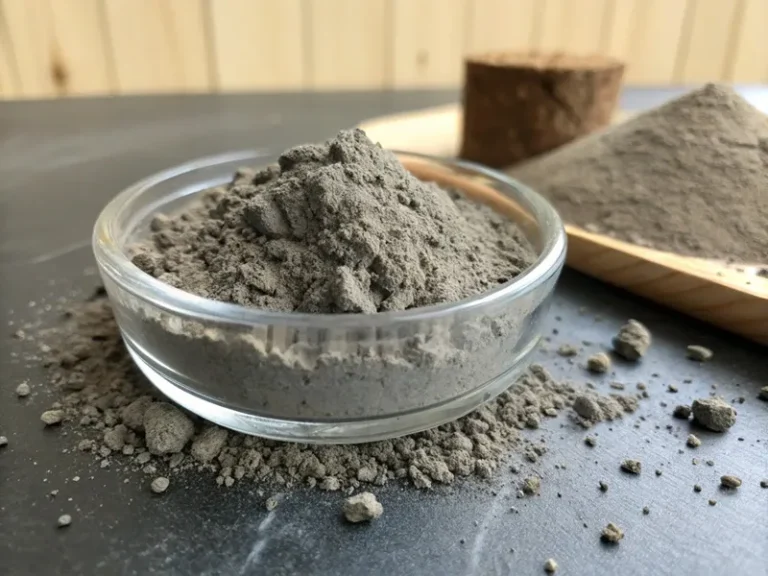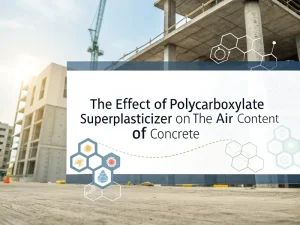
Can Polycarboxylate Superplasticizer Reduce The Water Cement Ratio Of Concrete?
Blog Can polycarboxylate
Blog

Concrete admixtures are chemicals or minerals added to concrete during mixing to alter its properties and meet specific engineering requirements. The use of admixtures has become crucial to meet the diverse and constantly evolving requirements of modern construction projects.
In this article, we will explore 15 types of admixtures used in concrete, their functions, and applications.
Water reducer is among the most commonly used additives. Their primary function is to reduce the water required in the concrete mixture while maintaining or improving its workability. The mechanism of action is to disperse cement particles and prevent them from clumping.
Ordinary water reducers can reduce water content by about 5-10%, as well as high-efficiency water reducers that can reduce water by 15-30% or more.
Water reducer are commonly used for high-strength concrete (such as skyscrapers and large bridges), prefabricated components, and pumped concrete.
Please read the specific types of water-reducer: Types of water reducing admixtures>>
The primary function of early strength agent is to accelerate concrete’s solidification and hardening process.
In cold weather concrete pouring, due to low temperatures, the normal hydration process of cement will slow down, and dry strength agents can help concrete solidify faster and obtain strength. They are also beneficial in projects with tight construction schedules, such as road maintenance or the construction of prefabricated components.
Calcium chloride is a well-known accelerator, but in some cases, it can cause corrosion of steel bars. Therefore, the number of non-chloride accelerators, such as calcium formate, is increasing.
On the contrary, retarders are used to delay the setting time of concrete. In some cases, this is crucial to ensure that concrete remains usable for longer.
High temperatures can cause concrete to solidify too quickly in hot weather conditions, making it difficult to pour and complete. Retarders are also used for large-scale concrete pouring, such as dams or large foundation slabs, which require longer working hours to ensure proper consolidation.
The function of the air-entraining agent is to introduce tiny and stable bubbles into the concrete mixture.
These bubbles play a crucial role in improving the durability of concrete, especially in environments with freeze-thaw cycles. When water freezes and expands within concrete pores, bubbles act as a buffer. They reduce the internal pressure that may cause cracking by providing space for water expansion. In addition, air-entraining agents can improve the workability of concrete, making it easier to pour and repair.
Air entraining agent mainly used for bridges, roads, and other structures in cold climates, as well as marine structures exposed to saltwater and moisture.
Corrosion inhibitors protect steel bars from corrosion. They work by forming a protective film on the surface of steel to prevent oxygen and moisture from entering, which is also the main cause of steel corrosion. Some corrosion inhibitors can also reduce the concentration of chloride ions around the steel, further reducing the risk of corrosion.
Corrosion inhibitors are commonly used in buildings, bridges, coastal ports, saline soil areas, underground tunnels, and marine structures.
Fly ash is a mineral admixture and a byproduct of coal-fired power plants. It mainly comprises small spherical particles of silicon dioxide, aluminum, and iron oxide.
When added to concrete, fly ash can replace a portion of cement, reducing the cost of concrete mixtures. It also improves the workability of concrete, reduces the heat of hydration (which is essential in pouring large-volume concrete), and enhances the long-term strength and durability of concrete by reacting with the calcium hydroxide produced during cement hydration.
Fly ash is commonly used in large-scale construction projects such as dams, bridges, and high-rise buildings.

GGBFS is another mineral mixture byproduct of the ironmaking process. It is a fine powder with a chemical composition similar to cement.
GGBFS can partially replace cement in concrete mixtures. It improves the durability of concrete by reducing permeability, enhancing resistance to chemical corrosion (such as sulfate corrosion), and increasing the long-term strength of concrete. In addition, it helps reduce the impact on the environment by utilizing industrial waste.
It is commonly used in concrete for marine structures, sewage treatment plants, and other applications that require high durability.
Silicon powder is an excellent byproduct of producing metallic silicon or ferrosilicon alloys. Due to its high silica content, it has extreme reactivity.
When added to concrete, silica fume fills the gaps between cement particles, forming a denser and more compact concrete structure. This leads to an increase in strength, an improvement in chemical resistance, and a decrease in permeability.
Silicon powder is commonly used in high-performance concrete applications, such as constructing prestressed concrete components and tunnel lining.
Attention: However, due to its fineness, silica fume will increase the water demand of concrete mixtures, so appropriate dosage and water management are crucial.
Fiber is a reinforcing agent added to concrete to increase its tensile strength and reduce cracking.
Steel fiber, polypropylene fiber, basalt fiber, and carbon fiber are commonly used in concrete. Carbon fiber is known for its high strength-to-weight ratio, which can significantly improve the strength and durability of concrete.
Fibers are mainly used in shotcrete and seismic-resistant structures.
Waterproof additives are added to concrete to reduce its water absorption and permeability, making it more waterproof.
Some waterproof additives form a hydrophobic layer on the surface of concrete pores. In contrast, others react with cement to form insoluble compounds blocking pores.
Waterproof additives are commonly used in basements, swimming pools, water tanks, and other structures that require water tightness
Concrete shrinks during the drying process, leading to cracking. The function of a reducing agent is to minimize this shrinkage as much as possible.
The working principle of shrinkage agents is to reduce the surface tension of pore water in concrete, thereby reducing the capillary pressure that causes shrinkage. By reducing shrinkage, they help prevent cracking and improve the overall integrity of concrete structures.
Shrinkage admixture are mainly used for large concrete slabs, such as industrial flooring and airport runways.
Expansion agents counteract concrete shrinkage and can also generate precompression in certain applications.
They react with cement and water to produce compounds, which expand upon hydration. This expansion can fill cracks and voids in concrete, improving its integrity.
In some cases, expansion agents are used for seamless road surfaces to prevent the formation of cracks due to shrinkage.
Add colorants to concrete to give it a specific color or hue. Add decorative colors to concrete.
Attention: When using coloring additives, it is important to ensure that they are compatible with other components of the concrete mixture and do not negatively impact the strength and durability of the concrete.
In underwater concrete pouring, there is a risk of cement slurry being washed away by water, which may lead to poor concrete quality. Anti-erosion additives are used to prevent this situation. These additives increase the viscosity of the concrete mixture, making it more resistant to the scouring effect of water. They also help maintain the integrity of underwater concrete structures.
Anti-eroding additives are mainly used in underwater construction projects, such as bridge piers, underwater foundations, and marine structures.

Defoamers reduce the presence of excessive bubbles in concrete mixtures. Although some bubbles are beneficial (such as in the case of air-entraining admixtures), excessive bubbles can decrease concrete strength and durability.
The working principle of defoamers is to decompose the surface tension of bubbles, causing them to coalesce and rise to a surface where bubbles can be removed.
Defoamers are commonly used in precast concrete production, which requires a smooth and dense surface finish. Certain types of admixtures or aggregates can cause concrete mixtures to foam excessively.
Concrete admixtures are crucial for adapting concrete to modern building needs. Each admixture has unique advantages and plays a vital role in customizing concrete performance to meet the specific requirements of different construction projects. By understanding the functions and applications of these 15 types concrete admixtures, construction professionals can make informed decisions to ensure the production of high-quality, durable, and cost-effective concrete structures.

Can Polycarboxylate Superplasticizer Reduce The Water Cement Ratio Of Concrete?
Blog Can polycarboxylate

The Effect Of Polycarboxylate Superplasticizer On The Air Content Of Concrete
Blog The effect of polyca